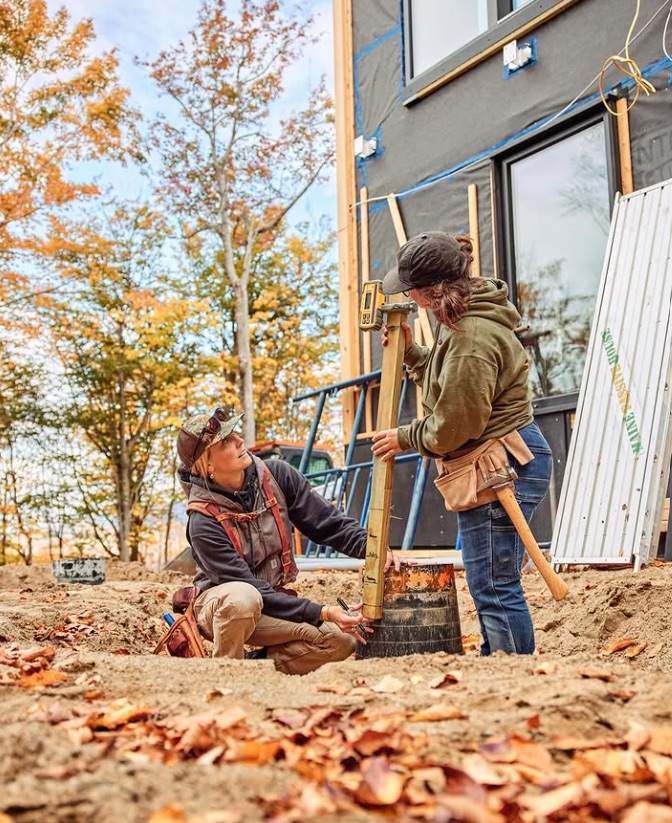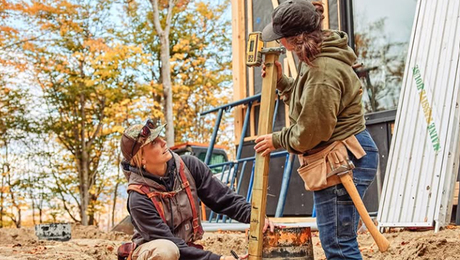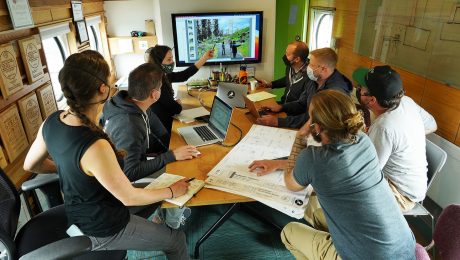Pros of Apprenticeship Programs
Apprenticeship programs can be a valuable tool for residential builders to recruit, train, and retain skilled employees, offering a structured pathway for career advancement and equity in the trades.

For many years, the most common approach to skilling up new hires has been informal, on-the-job training. Apprenticeship programs were primarily the purview of unions and specific trades like plumbing and electrical that required apprenticeships for licensure. But recently, more residential builders have been establishing apprenticeship programs as a strategy to recruit, train, and retain good employees.
A formal “registered apprenticeship” is a program approved by the state or an outside organization or union that requires specific hours of paid training and classroom instruction. Such a program ensures that the apprentice learns a variety of tasks.
This is one of the main factors that distinguish apprentice carpenters from entry-level laborers. If enrolled in a formal apprenticeship, they will need to show that they have accrued hours of experience under the supervision of a mentor doing different aspects of the trade, not only with cleanup or moving materials on a job site.
For small businesses, offering a formal apprenticeship can seem daunting due to paperwork, time investment, and potential costs. (Apprentice wages are usually similar to entry-level wages, but a bulk of the cost lies in leadership and oversight.)
However, those who have made the investment have found that new employees appreciate the structure and clear benchmarks that an apprenticeship program creates. It gives them a pathway for advancement, both in terms of skill level, raises, and additional responsibility.
There are a variety of ways to set up an apprenticeship program, so I reached out to three companies that launched carpentry apprenticeships in the past few years to see what we could learn from each of them.
Case Study 1: Creating a Custom Curriculum
Kevin Cradock Builders (KCB), founded in 1996, focuses on high-end residential projects with an emphasis on historic preservation. The company has grown to 50 employees and has an in-house millwork shop.
Over the years, Kevin noticed that in boom times, the local unions would snap up most of the graduates of the nearby trade school because of their ability to offer a structured apprenticeship program, along with competitive wages and benefits. However, not all of the students were inclined toward the larger scale of most union jobs.
During the pandemic, Kevin started to think more about launching his own apprenticeship program at KCB in order to attract new hires. Along with KCB’s director of construction, Nathan McBride, he developed a four-stage curriculum with a chart that includes over 700 skills each apprentice needs to learn, including both general carpentry skills as well as historic home–renovation skills specific to the high-end custom residential work KCB does.
It takes approximately one year to complete each level. The apprentices all are employed full-time by KCB and get a $2 per hour increase in pay when they complete each level. Currently, there are eleven apprentices—eight working in the field and three in the woodshop.

Some of the apprentices have come from high school vocational programs, some are new to the field, and others have had some experience working in carpentry. This cohort approach has been beneficial because it’s large enough to allow for group teaching sessions (all taught in-house by KCB staff).
KCB apprentices have one day and one evening a month in the classroom, plus on-the-job training (which is not billed to clients). Each apprentice is paired with a lead carpenter. Since launching the program in 2021, KCB has had a waitlist of people interested in joining.
When asked what advice he would give to other companies interested in starting an apprenticeship program, Kevin said, “You have to be flexible. Give people leeway and support for them to succeed.”
Case Study 2: Adapting a Structured Program
Garland Mill is a small, high-performance design-build firm in northern New Hampshire. For years, the team had talked about hiring an apprentice because carpenters are hard to find in their rural area, but they were daunted by the time it takes to train an entry-level employee.
In 2023, Garland Mill’s Ben Southworth and Crystal Shallow met a representative from Apprenticeship New Hampshire, a statewide program that promotes formal apprenticeships. After learning about the program, they decided it would be a good fit for Garland Mill.
Apprenticeship New Hampshire follows the National Center for Construction Education and Research (NCCER) curriculum, which requires three semesters of coursework plus 6000 hours of on-the-job training (approximately three years full-time). Ben and Crystal reviewed the standard carpentry skills requirements and added their own custom module focused on building science. Then after meeting with the U.S. Department of Labor, they launched their registered apprenticeship.
Garland Mill hired its first apprentice in the summer of 2024. He completed an eight-week classroom module over the summer and then started his on-the-job training in the fall. He works two 10-hour days on Mondays and Wednesdays, then works Tuesday and Thursday mornings before making the two-hour drive to Concord, N.H., for the classroom sessions on Tuesday and Thursday evenings along with 10 other apprentices from across the state. One Saturday a month the cohort does a field trip together.
One of the biggest challenges for Garland Mill is its rural location. The classroom portions of the curriculum have to be completed in person. Garland Mill pays its apprentice for his mileage one-way, in addition to paying the tuition for the course, but doesn’t pay him for the classroom time.
Garland Mill’s new apprentice was assigned a mentor who reviews the apprentice’s progress and helps him fill out his “ApprentiScope” app. While Garland Mill eventually would like to have two apprentices at a time, finding folks who are willing to be mentors is a challenge. In addition, with Garland Mill’s size (about 12 people), there are typically only two or three jobs running at a time, and the company wouldn’t want more than one unskilled person on each job.
In terms of lessons learned, Crystal shared, “Jumping into an established program allowed us to get our program up and running much quicker than if we had developed it ourselves from scratch.”
Case Study 3: A Focus on High Performance
Anna Heath is co-owner of Maine Passive House (MPH), as well as a project manager who has helped the company recruit and retain a number of new hires, with a specific focus on bringing more women into the trades. MPH has a team of 16 employees in western Maine, focusing on high-performance homes and renovations.
In 2021, Anna reached out to the Maine Department of Labor to learn more about how to establish an apprenticeship program. Because Maine is a rural state, a portion of the apprenticeship classroom hours can be completed through online courses.
The in-person courses are offered through the state’s community college system, but the closest campus is nearly an hour away, and there aren’t always enough apprentices to justify offering the courses in a given semester. The community colleges also struggle to find qualified instructors to teach the courses.

For MPH, the process of establishing a formal apprenticeship program was daunting and the cost was prohibitive. But then the company discovered Educate Maine, an “intermediary sponsor” whose job is to help companies start apprenticeship programs and provide support services for the apprentices (for example, help with transportation or with funds to buy a laptop to use for online courses).
After reviewing the state-established carpentry apprenticeship requirements, the team at MPH wanted to ensure that their apprentices would learn the specifics of high-performance construction. So they created a new apprenticeship called “Passivehouse Journeyworker,” which requires 4000 hours of on-the-job training plus 295 classroom hours.
They used their software for tracking tasks, costs, and timelines for client projects as a framework to identify required skills in each category and to attach a certain number of hours to the skills. Having the apprenticeship framework match their existing system makes tracking apprentice hours easy.
As the program progressed, MPH realized that apprenticeships are not only applicable for entry-level hires but can also be used to provide structure for mid-level positions. The company has since launched a lead carpenter apprenticeship specific to the skills of site supervision and is considering a project manager apprenticeship.
If you’re looking to start your own apprenticeship program, Anna recommends connecting with an intermediary sponsor in your state as well as your Workforce Innovation and Opportunity Act (WIOA) representative, who can assist with accessing different funding sources to help subsidize the costs for both the company and the apprentice.
“The apprenticeship has proven to be a real equalizer,” Anna said. “It helps women and minorities get promoted because they can document their skills. It also gives everyone on the crew the permission to teach and to learn.”
Each of these companies has taken a different approach to creating an apprenticeship and has navigated state and federal programs. That takes time—developing the program can be labor- and bureaucracy-intensive, and it involves significant time investments from a business. Mentors are key; you’ll need folks on your team who are able and willing to serve as mentors to the apprentices. It will take years for new employees to complete the apprenticeship, and not all will complete it.
But in a labor shortage, starting an apprenticeship program is a solid strategy for attracting and training a skilled workforce. Apprenticeships offer a pathway for training and advancement that can benefit everyone in the company. And critically, structure supports equity—an apprenticeship program can level the playing field, especially for folks who are traditionally underrepresented in the trades, and help ensure they are compensated fairly.
— Kate Stephenson; cofounder of HELM Construction Solutions, a planet- and people-forward firm with expertise in construction, management, leadership, and training.
RELATED STORIES




























